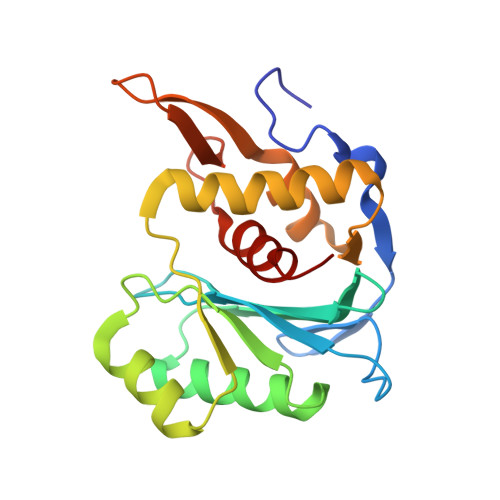Viral genome packaging terminase cleaves DNA using the canonical RuvC-like two-metal catalysis mechanism.
Xu, R.G., Jenkins, H.T., Chechik, M., Blagova, E.V., Lopatina, A., Klimuk, E., Minakhin, L., Severinov, K., Greive, S.J., Antson, A.A.(2017) Nucleic Acids Res 45: 3580-3590
- PubMed: 28100693
- DOI: https://doi.org/10.1093/nar/gkw1354
- Primary Citation of Related Structures:
5M1F, 5M1K, 5M1N, 5M1O, 5M1P, 5M1Q - PubMed Abstract:
Bacteriophages and large dsDNA viruses encode sophisticated machinery to translocate their DNA into a preformed empty capsid. An essential part of this machine, the large terminase protein, processes viral DNA into constituent units utilizing its nuclease activity. Crystal structures of the large terminase nuclease from the thermophilic bacteriophage G20c show that it is most similar to the RuvC family of the RNase H-like endonucleases. Like RuvC proteins, the nuclease requires either Mn2+, Mg2+ or Co2+ ions for activity, but is inactive with Zn2+ and Ca2+. High resolution crystal structures of complexes with different metals reveal that in the absence of DNA, only one catalytic metal ion is accommodated in the active site. Binding of the second metal ion may be facilitated by conformational variability, which enables the two catalytic aspartic acids to be brought closer to each other. Structural comparison indicates that in common with the RuvC family, the location of the two catalytic metals differs from other members of the RNase H family. In contrast to a recently proposed mechanism, the available data do not support binding of the two metals at an ultra-short interatomic distance. Thus we postulate that viral terminases cleave DNA by the canonical RuvC-like mechanism.
Organizational Affiliation:
York Structural Biology Laboratory, Department of Chemistry, University of York, York YO10 5DD, UK.

















